Mindfulness meditation significantly enhances mental health by reducing stress, anxiety, and depression. This article explores effective techniques such as focused breathing and body scans, highlights the benefits supported by scientific research, and addresses common misconceptions. It also discusses how mindfulness can complement therapeutic practices and offers guidance for beginners to start their journey.
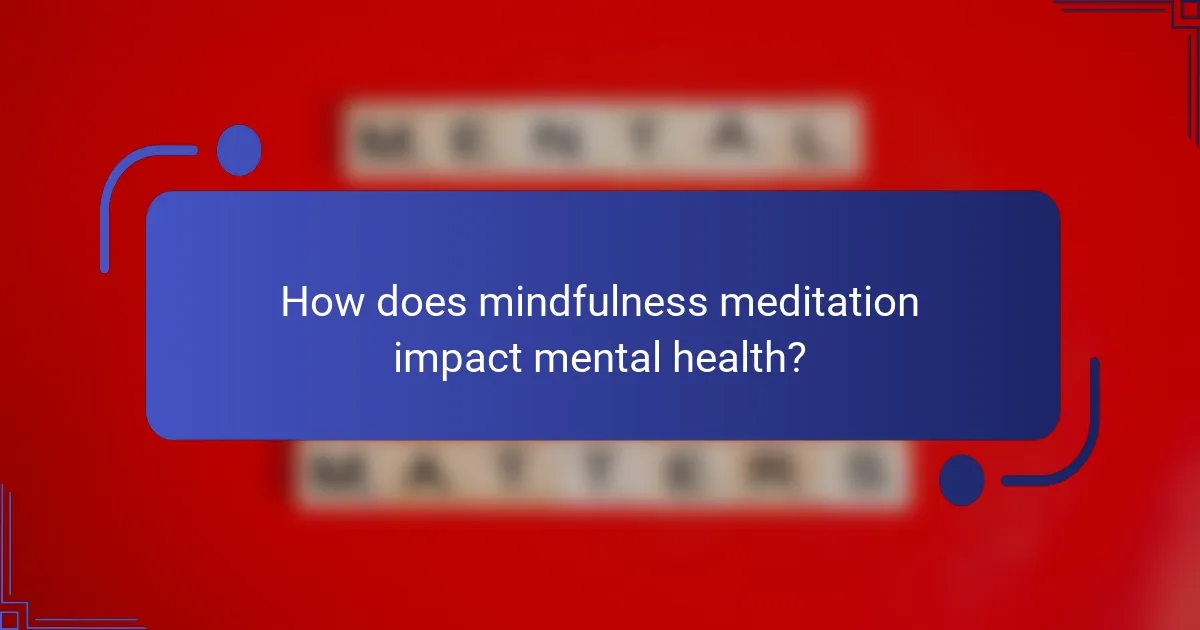
How does mindfulness meditation impact mental health?
Mindfulness meditation significantly improves mental health by reducing stress, anxiety, and depression. Research shows it enhances emotional regulation and increases overall well-being. Techniques include focused breathing, body scans, and mindful observation. A study found that consistent practice can lead to measurable changes in brain structure related to stress response.
What are the psychological benefits of mindfulness meditation?
Mindfulness meditation offers significant psychological benefits, including reduced anxiety and improved emotional regulation. Regular practice enhances self-awareness and promotes a greater sense of well-being. Studies show mindfulness can decrease symptoms of depression and increase overall life satisfaction. These effects arise from the practice’s ability to foster a non-judgmental awareness of thoughts and feelings, leading to healthier coping mechanisms.
How does mindfulness meditation compare to traditional therapy?
Mindfulness meditation offers a different approach to mental health compared to traditional therapy. While traditional therapy often involves verbal communication with a therapist to explore thoughts and feelings, mindfulness meditation emphasizes present-moment awareness and non-judgmental acceptance of experiences.
Mindfulness practices can enhance emotional regulation and reduce anxiety, often providing immediate relief. In contrast, traditional therapy may require more time to yield significant changes, as it often delves into past experiences and cognitive patterns.
Research shows that mindfulness meditation can lead to reductions in symptoms of depression and anxiety comparable to those achieved through therapy. For instance, a meta-analysis found that mindfulness-based interventions produced moderate to large effects on anxiety and depression.
Both methods have unique attributes; mindfulness meditation is often more accessible and can be practiced independently, while traditional therapy provides structured support from a trained professional. Each approach can be beneficial depending on individual needs and preferences.
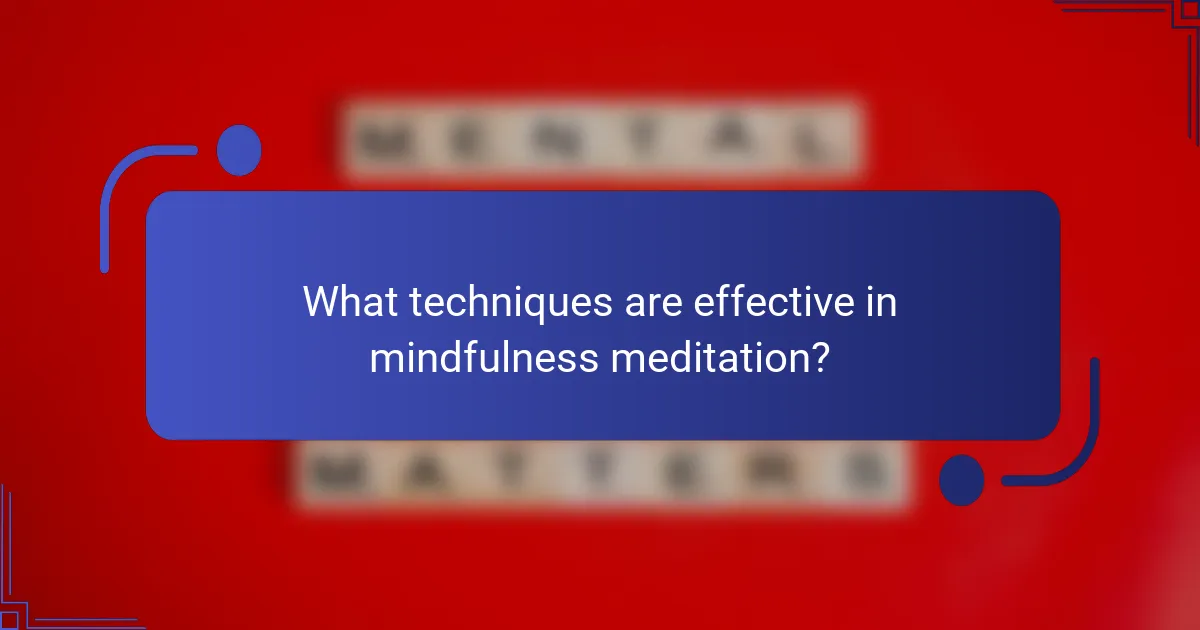
What techniques are effective in mindfulness meditation?
Effective techniques in mindfulness meditation include focused attention, body scan, and loving-kindness meditation. These methods enhance mental health by reducing stress and improving emotional regulation. Focused attention involves concentrating on the breath, which fosters awareness. The body scan technique promotes relaxation by progressively focusing on different body parts. Loving-kindness meditation encourages compassion towards oneself and others, boosting overall well-being. Research supports these techniques, showing significant benefits for mental health.
Which mindfulness meditation techniques are most popular?
Mindfulness meditation techniques such as body scan, breath awareness, and loving-kindness are among the most popular. These methods promote mental health by reducing stress and enhancing emotional well-being.
Body scan involves focusing attention on different parts of the body, promoting relaxation and awareness. Breath awareness centers on observing one’s breathing patterns, which helps anchor the mind. Loving-kindness meditation encourages the cultivation of compassion towards oneself and others, fostering positive emotions.
Research supports these techniques, showing significant benefits for anxiety and depression management. Regular practice can lead to lasting improvements in mental health.
How can one practice mindfulness meditation daily?
To practice mindfulness meditation daily, set aside a specific time each day for focused practice. Start with short sessions, gradually increasing duration as you become more comfortable. Use guided meditations or apps to help maintain focus. Incorporate mindfulness into daily activities, such as eating or walking, to reinforce the practice. Consistency and patience are key for long-term benefits.
What role does breathwork play in mindfulness meditation?
Breathwork enhances mindfulness meditation by promoting relaxation and focus. This practice encourages deep, intentional breathing, which reduces stress and anxiety. Research shows that breathwork can improve emotional regulation and increase present-moment awareness. As a result, practitioners often experience heightened mental clarity and emotional stability.

Why is scientific support important for mindfulness meditation?
Scientific support is crucial for mindfulness meditation as it validates its effectiveness for mental health. Research demonstrates measurable benefits, such as reduced anxiety and improved emotional regulation. Scientific studies provide a framework for understanding how mindfulness alters brain function and promotes resilience. This evidence encourages wider acceptance and integration into therapeutic practices, enhancing credibility and accessibility for individuals seeking mental health solutions.
What studies validate the benefits of mindfulness meditation for mental health?
Numerous studies validate the benefits of mindfulness meditation for mental health, demonstrating reductions in anxiety, depression, and stress. Research published in JAMA Internal Medicine found that mindfulness meditation programs significantly improved mental health outcomes. Another study in Psychological Science showed enhanced emotional regulation among participants practicing mindfulness. Additionally, a meta-analysis in Psychological Bulletin confirmed mindfulness meditation’s effectiveness in reducing symptoms of anxiety and depression across diverse populations. These findings underscore mindfulness meditation’s role as a valuable tool for improving mental health.
How does neuroscience explain the effects of mindfulness meditation?
Neuroscience explains mindfulness meditation’s effects through brain changes that enhance emotional regulation and reduce stress. Studies show increased gray matter density in areas related to self-awareness and empathy. Neuroimaging reveals altered activity in the amygdala, which is associated with fear and anxiety responses. Regular practice strengthens neural pathways, improving cognitive flexibility and resilience.
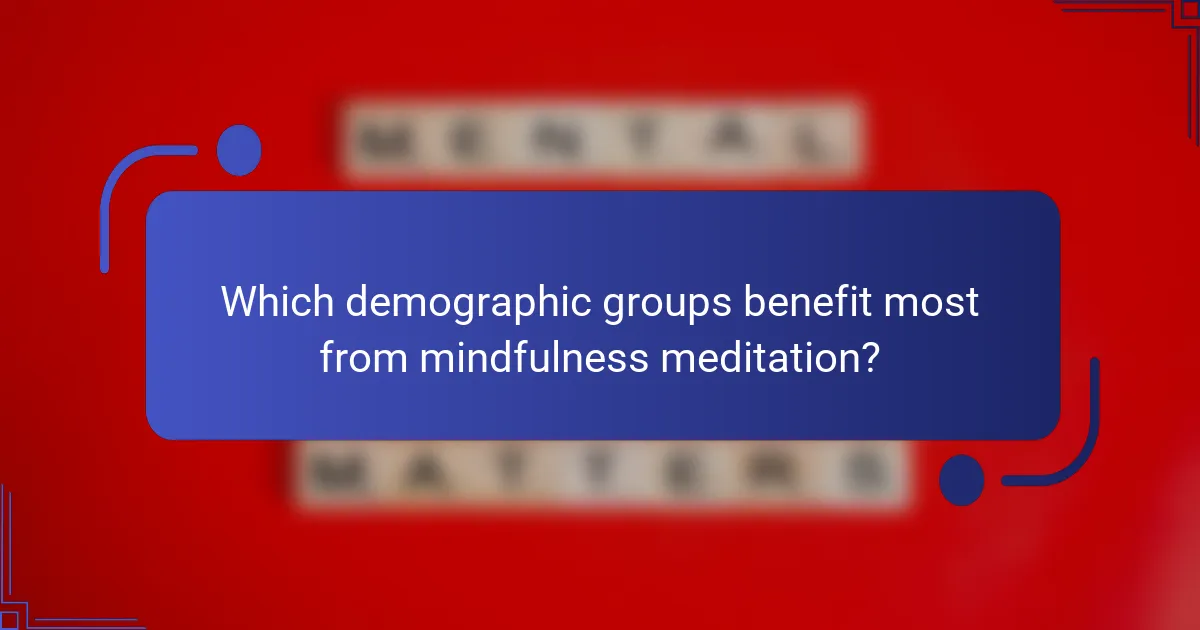
Which demographic groups benefit most from mindfulness meditation?
Mindfulness meditation benefits various demographic groups, particularly those experiencing stress, anxiety, and depression. Research indicates that children, adolescents, and older adults show significant improvements in mental health through mindfulness practices. Additionally, individuals with chronic illnesses report reduced symptoms and enhanced emotional well-being. Studies reveal that mindfulness meditation can lead to lower cortisol levels and improved emotional regulation across these groups.
How do cultural perceptions of mindfulness meditation vary?
Cultural perceptions of mindfulness meditation vary significantly across different societies. In some cultures, mindfulness is viewed as a spiritual practice, while in others, it is seen as a mental health tool. For instance, in Western contexts, mindfulness often emphasizes stress reduction and emotional regulation, supported by scientific studies. In contrast, Eastern cultures may integrate mindfulness into broader spiritual traditions, highlighting its connection to overall well-being and enlightenment. These differing perspectives influence how mindfulness techniques are taught and practiced, affecting their adoption and effectiveness.
What unique challenges do different age groups face in practicing mindfulness meditation?
Different age groups face unique challenges in practicing mindfulness meditation. Children may struggle with attention spans, while teenagers often deal with peer pressure and emotional turbulence. Adults frequently face time constraints and stress from work and family responsibilities. Older adults might encounter physical limitations and cognitive decline, impacting their ability to engage fully. Each group requires tailored approaches to mindfulness that address their specific hurdles.
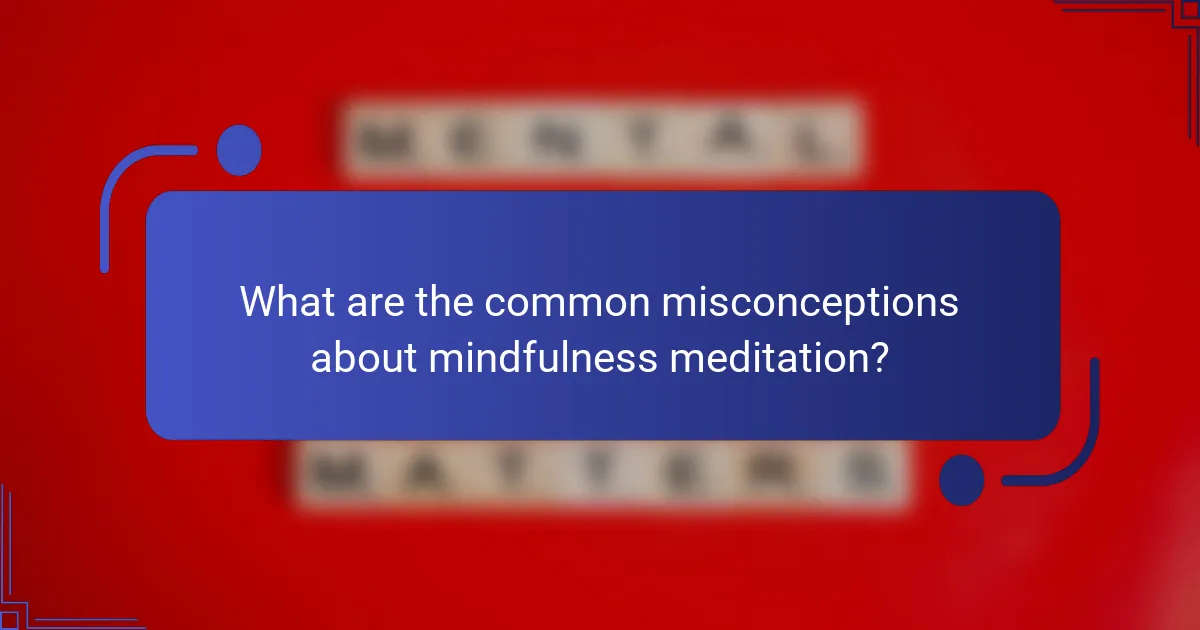
What are the common misconceptions about mindfulness meditation?
Many misconceptions about mindfulness meditation exist, often hindering its practice. One common belief is that mindfulness requires emptying the mind, whereas it actually involves observing thoughts without judgment. Another misconception is that mindfulness is only for relaxation; in reality, it enhances emotional regulation and mental clarity. Some people think mindfulness meditation is a quick fix for stress, but consistent practice is necessary for lasting benefits. Lastly, many assume that mindfulness is only for spiritual seekers, while it is accessible and beneficial to anyone seeking improved mental health.
Why do some people find mindfulness meditation difficult?
Some people find mindfulness meditation difficult due to distractions, unrealistic expectations, and emotional discomfort. Distractions can stem from external noise or internal thoughts that interrupt focus. Unrealistic expectations may lead to frustration if immediate results are not experienced. Emotional discomfort arises when facing underlying issues, making it challenging to remain present. These factors can hinder the ability to engage fully in the practice, impacting its effectiveness for mental health.
What myths about mindfulness meditation should be debunked?
Many myths about mindfulness meditation can mislead practitioners. One common myth is that mindfulness requires complete mental silence, while in reality, it involves observing thoughts without judgment. Another misconception is that mindfulness is a quick fix for mental health issues, but research shows it is most effective with consistent practice over time. Some believe mindfulness meditation is only for the spiritually inclined, yet it is accessible and beneficial for anyone seeking improved mental health. Lastly, some think mindfulness meditation is ineffective without a teacher, whereas self-guided practices can also yield significant benefits.
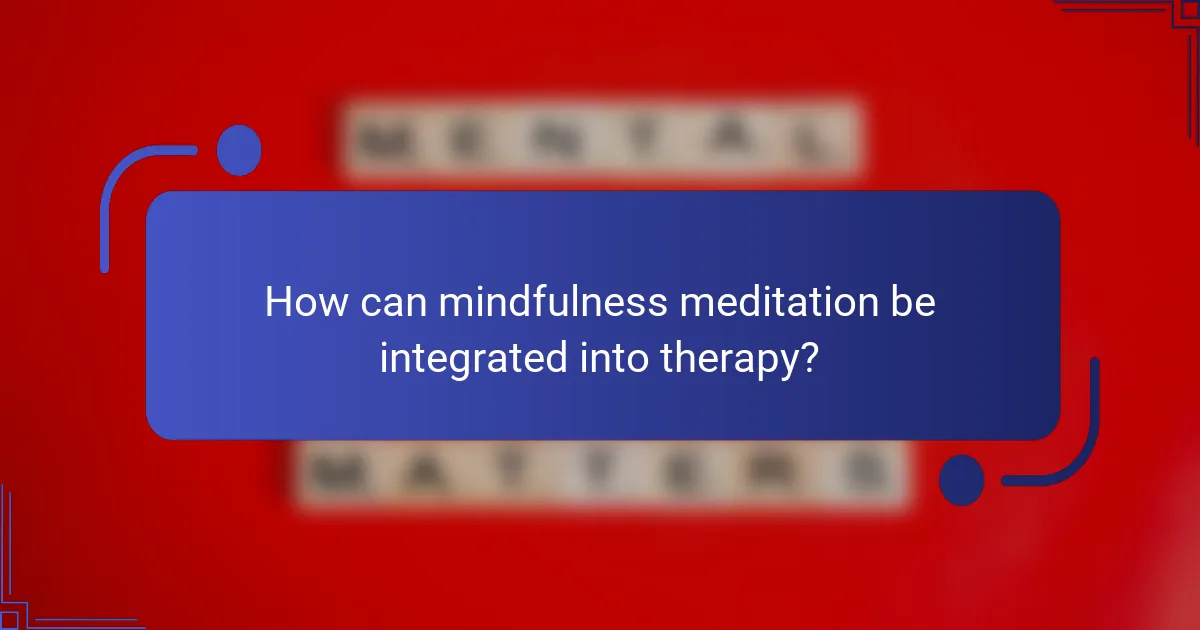
How can mindfulness meditation be integrated into therapy?
Mindfulness meditation can enhance therapy by promoting self-awareness and emotional regulation. Integrating mindfulness techniques helps clients manage anxiety, depression, and stress. Research indicates that mindfulness practices can reduce symptoms and improve overall mental health. Techniques such as focused breathing, body scans, and mindful observation can be incorporated into therapeutic sessions to support healing and personal growth.
Which therapeutic approaches incorporate mindfulness meditation?
Mindfulness meditation is incorporated into various therapeutic approaches, including Acceptance and Commitment Therapy (ACT), Mindfulness-Based Stress Reduction (MBSR), and Dialectical Behavior Therapy (DBT). These methods utilize mindfulness to enhance emotional regulation, reduce stress, and improve overall mental health outcomes. Research supports their efficacy, showing significant reductions in anxiety and depression symptoms.
What are the potential risks of mindfulness meditation in therapy?
Mindfulness meditation can pose risks in therapy, including increased anxiety, emotional discomfort, and dissociation. These effects may arise from confronting suppressed emotions or traumatic memories during practice. Individuals with certain mental health conditions, such as PTSD or severe anxiety disorders, may experience exacerbated symptoms. It is crucial for therapists to assess clients’ readiness and provide appropriate support.
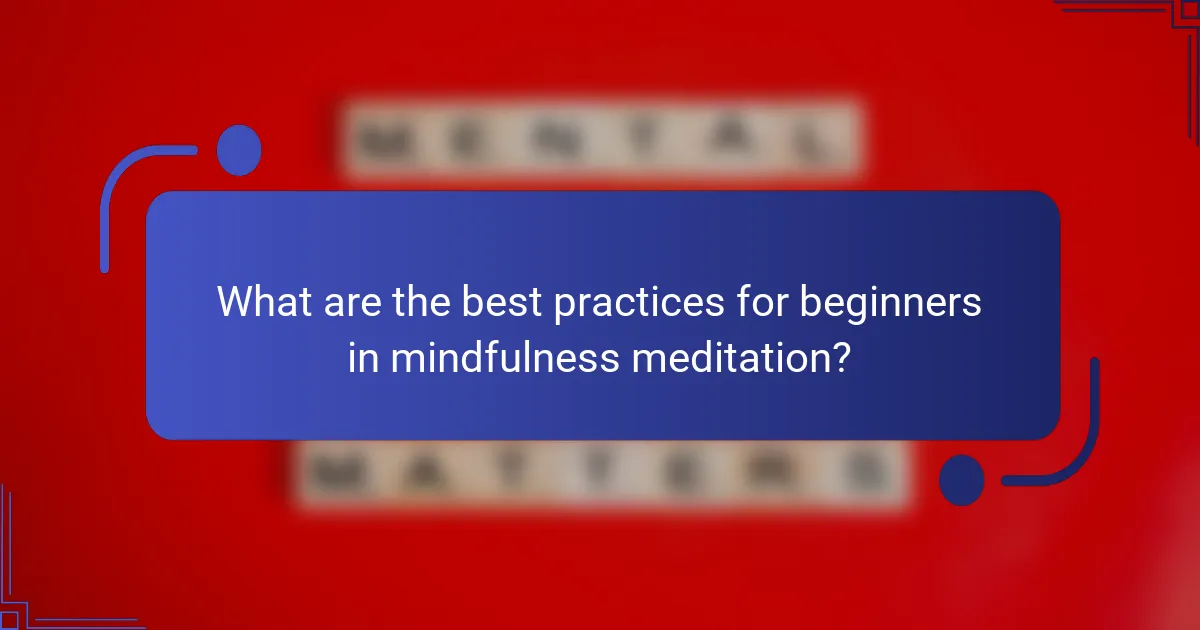
What are the best practices for beginners in mindfulness meditation?
To practice mindfulness meditation effectively, beginners should focus on consistency, simplicity, and patience. Start with short sessions, gradually increasing duration as comfort grows. Establish a quiet space, free from distractions, to enhance focus. Use guided meditations or apps for structure, ensuring a supportive learning environment. Lastly, approach the practice without judgment, allowing thoughts to come and go freely.
How can one create a conducive environment for mindfulness meditation?
Creating a conducive environment for mindfulness meditation involves several key aspects. First, select a quiet space free from distractions. Ensure comfortable seating or lying arrangements to promote relaxation. Incorporate soft lighting and calming colors to enhance the atmosphere. Consider adding elements like plants or soothing sounds to foster tranquility. Lastly, establish a consistent routine to signal your mind that it’s time for meditation.
What common mistakes should beginners avoid in mindfulness meditation?
Beginners in mindfulness meditation should avoid common mistakes like striving for perfection, forcing thoughts away, and neglecting posture. These errors can hinder the meditation experience and reduce its mental health benefits.
1. Expecting immediate results can lead to frustration.
2. Judging thoughts instead of observing them disrupts mindfulness.
3. Skipping regular practice diminishes progress.
4. Ignoring breath awareness can limit relaxation and focus.
5. Overthinking techniques can create unnecessary stress.
6. Comparing progress with others detracts from personal growth.
How can mindfulness meditation be tailored to individual needs?
Mindfulness meditation can be tailored to individual needs by incorporating personal preferences and specific mental health goals. Techniques such as guided imagery, body scans, or breath-focused practices can be adjusted based on the individual’s comfort and experience level.
For example, beginners may benefit from shorter sessions, while experienced practitioners might prefer longer, more intensive practices. Additionally, individuals can choose settings that resonate with them, whether a quiet room or a natural environment.
Moreover, integrating mindfulness into daily activities, like mindful eating or walking, allows for personalization. Scientific studies suggest that tailored approaches enhance the effectiveness of mindfulness meditation, leading to improved mental health outcomes.


